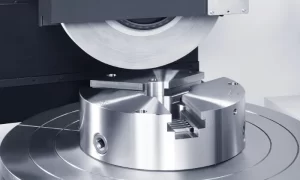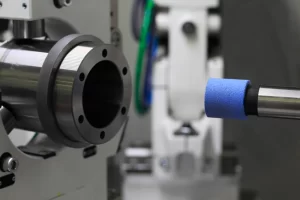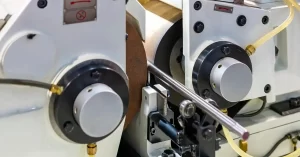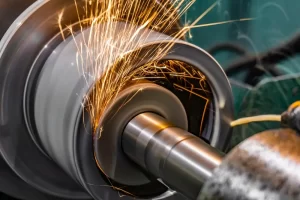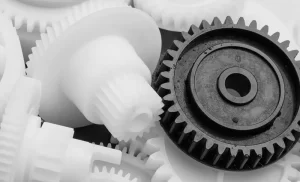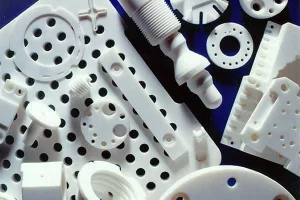CAPABILITIES
Grinding Machining Service
Quality CNC grinding services to exact the dimensions and customize the surface finish of your parts, from matte to glossy aesthetic.
- Metal, Alloys, Plastics, and Composites
- ID/OD/ Profile/Surface grinding
- Tolerance as low as ±0.0125mm
- Ra as low as 0. 025 to 3.2 µm respectively
- A quick lead time of 1 day






All uploads are secure and confidential.
Our CNC Grinding Machining Service

Grinding machining eliminates surface imperfection and irregularities through abrasive wheels. The abrasive grits remove minor materials to achieve tight dimensional tolerances and surface finish. Our CNC Grinding machining service can finish any type of geometry, including internal, external, centerless, and cylindrical grinding.
You can get high-precision and ISO-certified parts according to your design specifications. Our decade of experience and use of custom abrasive wheels allow us to handle any challenging or complex grinding project.
We are also flexible with the required surface texture and specifications like roundness, cylindricity, and roughness. Every design is executed to meet your tailored needs!
Our Grinding Machining Capabilities
| Size limitation | (1050mm x 820mm x 305mm) |
| Linear tolerance | ±0.0125mm |
| Roundness | ±0.005mm |
| Cylindricity | ±0.005mm |
| Electrode diameter | 0.100 to 0.33mm |
| Surface Roughness | 0. 025 to 3.2 µm for the critical parts |
| Further treatment | Polishing, Anodizing, Power Coat, Plating, etc. |
Try Prolean Now!
Advantages of CNC Grinding Machining

- High-Quality Finish
It removes all surface irregularities, machining chips, burrs, stains, and debris, creating a uniform and smooth surface. Grinding can create a matte, glossy, or even mirror-like finish with the polishing. The grinding surface is also ideal for further treatment like electroplating and anodizing.

- Tight Tolerances
The CNC grinding can achieve tight tolerance with minor material removal from the parts, often as low as 0.0125mm (0.001”). It also produces complex shapes with fine tolerances that are difficult to achieve with traditional methods.

- Consistent Quality and Repeatability
CNC grinding machining ensures consistent quality across each production cycle. The repeatability of CNC processes minimizes the risk of human error, resulting in high-quality components that meet exact specifications
Grinding Machining & Quality Control

Quality control is related to dimensional accuracies, surface quality, and the performance of final parts. Here, grinding machining exacts the designed tolerances and produces quality surfaces for end use or further treatments. Therefore, the grinding operations facilitate the quality control of manufactured items, whether they are CNC machined, cast, or extruded shapes.
- Error minimization: The grinding wheel minimizes errors by correcting minor deviations from previous machining processes. It can meet strict dimensional specifications.
- Preparation for Further Processes: The grinding surface is ideal for further coatings, treatments, and precision assembly.
- Easier Inspection: Well-grinded parts with consistent dimensions and finishes are easier to inspect during quality control.
- Defect Analysis: A finely finished surface makes it easier to detect and analyze even minor defects or imperfections.
Grinding Machining Options
Based on the geometry of the parts to be grinded, you can choose suitable options from below. Each of them has unique capabilities and benefits.
Surface Grinding
Surface Grinding
This is the most common option used to refine flat surfaces of parts side by side. The rotating wheel can be set either horizontally or vertically to the table according to needs. The worktable feeds the workpiece into a wheel, and then abrasives on wheels remove the material. Typically, the roughness level ranges from Ra 0. 025 to 3.2 (µm).
When to Use?
- To achieve a higher degree of flatness
- For tight tolerances
- If further coatings, plating, or other treatment are necessary.
Cylindrical Grinding
Cylindrical Grinding
It refers to the grinding of cylindrical and tapered surface profiles. In this process, the headstock’s chuck holds the workpiece, and the position of the grind wheel is alongside. Next, pushing the wheel toward rotating workpieces feeds the material to meet the dimensional and cylindricity requirements. Meanwhile, you can achieve the roughness (Ra) as low as 0.707 μm.
When to Use?
- For precision cylindrical shapes, such as in shafts, rollers, bearings, etc.
- To achieve smooth external surfaces of cylindrical or tapered parts.
- If a part’s roundness and concentricity affect the performance
Centerless Grinding
Centerless Grinding
Unlike conventional cylindrical grinding, centerless grinding does not use a fixed center to hold the workpiece. Instead, a regulating wheel and the blade structure support the workpiece during the grinding machining. It is possible to finish with a roughness range of 0.1–2µm using centerless grinding.
When to Use?
- For high-volume production of cylindrical parts
- If you need fast and consistent grinding
- For small cylindrical components
Internal Grinding
Internal Grinding
Here both grinding wheel and workpiece rotate while grinding the internal surfaces of internal cylindrical or conical geometries. It can achieve the desired inner diameter and surface finish, (as low as 0.707 μm.
When to Use?
- Grinding of internal surfaces requires precision like bearing races and bushings.
- For machining internal diameters with tight tolerances.
Materials that can be grinded
Our CNC grinding facility can accommodate metals, plastics, composites, and ceramics. We use a custom abrasive wheel according to the specific material type.
Metals
We can grind several metals and alloys utilizing the right abrasive material based on their hardness and thermal properties.
- Steel
- Stainless Steel
- Titanium
- Aluminum
- Copper
- Brass
- Nickel alloys
- Tungsten alloys
Plastics
We focus on the heat sensitivity and brittleness of plastics to avoid any minimal surface damage while grinding; fine and soft aggressive are used. Our grinding equipment is also equipped with coolants and air blasts to tackle excessive heat generation.
- Polytetrafluoroethylene (PTFE)
- Acrylonitrile Butadiene Styrene(ABS)
- Acrylics
- Polycarbonate
- Nylon
Ceramics
Ceramics are known for high hardness and thermal resistance, used in a wide variety of projects. Regarding their hardness, we use super abrasives like diamond abrasive wheels.
- Alumina
- Zirconia
- Silicone Carbide
Composites
Composites are the material matrix bound with suitable resins. They offer a high strength-to-weight ratio and durability. We can grind different composite materials;
- Fiberglass
- Carbon fiber composites
- Fiber-reinforced plastics
Metals
Metals
We can grind several metals and alloys utilizing the right abrasive material based on their hardness and thermal properties.
-
- Steel
- Stainless Steel
- Titanium
- Aluminum
- Copper
- Brass
- Nickel alloys
- Tungsten alloys
Plastics
Plastics
We focus on the heat sensitivity and brittleness of plastics to avoid any minimal surface damage while grinding; fine and soft aggressive are used. Our grinding equipment is also equipped with coolants and air blasts to tackle excessive heat generation.
- Polytetrafluoroethylene (PTFE)
- Acrylonitrile Butadiene Styrene(ABS)
- Acrylics
- Polycarbonate
- Nylon
Metals
Ceramics
Ceramics are known for high hardness and thermal resistance, used in a wide variety of projects. Regarding their hardness, we use super abrasives like diamond abrasive wheels.
-
-
- Alumina
- Zirconia
- Silicone Carbide
-
Composites
Composites
Composites are the material matrix bound with suitable resins. They offer a high strength-to-weight ratio and durability. We can grind different composite materials;
-
-
- Fiberglass
- Carbon fiber composites
- Fiber-reinforced plastics
-
How to Order Parts?
Get a free quote from a real engineer; once we receive your design, our engineer will review it and send you a quote as fast as one hour.

Get A Quote Immediately
Upload your design or email our engineer directly and get your quotes as fast as one hour.

Start Production
Your parts will be made once your orders are confirmed. Besides, you will get real-time order updates of the production status from our order tracking system.

Receive Your Part
After all parts pass QC inspection, they will be well packed from transportation accidents. Then, your custom parts are delivered straight to your doorstep.
Industry Application of Grinding Machining

Automotive
CNC grinding makes highly precise and small automotive components, which support the growing safety and performance needs in vehicle manufacturing. For instance, pistons, cylinders, gears, bushings, exhaust manifolds, crankshafts, camshafts, and steering racks.

Aerospace
The use of high-performance materials like titanium alloys and custom composites is increasing in the aerospace industry. Traditional machining methods face challenges due to material hardness and unique properties. But, CNC grinding can exact the dimensions and perfect the surface for subsequent coating.
Examples: Turbine blades, landing gear, fuel system parts, actuator housing, heat shields, engine mounts, propeller shafts, etc.

Medical
Medical equipment, surgical instruments, and implants demand extremely high precision and biocompatibility in their components. CNC grinding meets the required smoothness and strict regulatory standards.
Examples: Needles, syringes, guidewires, catheters, bone screws, prosthetic components, and medical implants.

Tooling
The dimensional accuracy and surface finish of molds and die directly impact the overall precision and quality of molding and die-casting parts. CNC grinding is used to finish the cavity surface of tooling like mold, dies, and punches. Additionally, grinding also sharpens the shear-cutting tools.
Examples: Cutting tools, dies, molds, tool holders, grinding wheels, etc.

Electronic
You can grind the electronic components for precise dimensions and surface preparation. So, further aesthetic coating and colors can be applied to achieve an appealing appearance. Some application examples are semiconductor parts, circuit board components, heat sinks, transistor housing, battery contacts, and connector pins.
Grinding Machining FAQs
On which materials precision grinding can be applied?
Which factors contribute to the premium quality of the finish?
The quality of the finish and optimum tolerance require precise control over configuration aspects, for instance;
- Grit size, shape, and wheel type used.
- The speed of the wheel
- Type of abrasive materials used
- Concisely controlled feed rates
What machine is used for precision grinding?
What is the accuracy of the precision grinder?
Which factors contribute to the premium quality of the finish?
- Grit size, shape, and wheel type used
- The speed of the wheel
- Type of abrasive materials used
- Concisely controlled feed rates
Get Your Parts Made Today
All uploads are secure and confidential.

